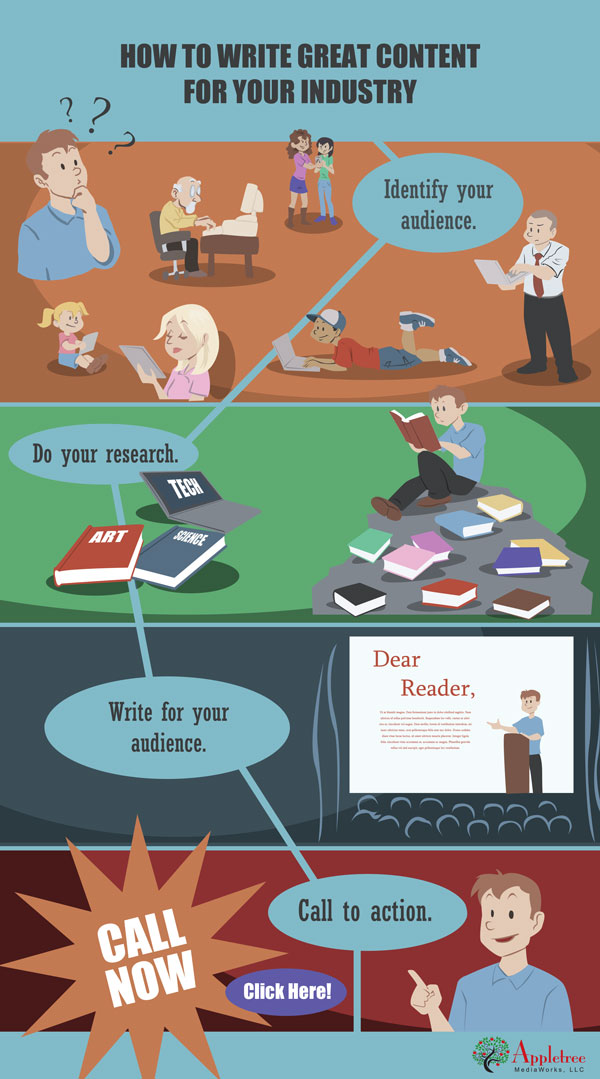Union Tech Tips
It’s Appletree MediaWorks’ 5th birthday and we’ve been helping many unions and locals make sure they’re seen out on the web in that time. Things have changed quickly on the internet – technology moves fast – so below are some universal union tech tips for your own personal computing and your union’s presence on the web!
Keep Your Website Up to Date
We all use Facebook for lots of updates, but Facebook has made some changes which result in members missing a lot of posts. This is another example of why you should consider your website to be your hub for info and post all relevant info there. Updating a website regularly also makes it climb higher in Google, and makes viewers feel like something is going on. Give them a reason to check out your site regularly! UWUA Local 304 presents a good example of regular updates with engaging content.
Change your Passwords
After Heartbleed and other various internet threats, it’s become clear the best thing you can do is change your passwords regularly and make sure you don’t use the same password everywhere. Worried you’ll forget your passwords? There’s software for that! Read more at the Appletree Media blog.
Clean Up Your Computer
Does your computer feel like it’s been going slower? Do you have popups and toolbars? Are there fingerprints all over your monitor? Cleaning your PC is a bit of regular maintenance that we don’t always think about. Get some canned air for the PC’s vents, use a dry or slightly damp (with water) microfiber cloth for your monitors. Run a program like Malwarebyte’s AntiMalware or CCleaner, and defrag your computer. It might not be good as new afterwards, but it will be a lot closer.
Back Up Your Files
Many people never think to backup their files until the worst happens and you lose access to them. Maybe your hard drive dies, or maybe you get hit with some bad malware, but it’s always better to backup your important files before that happens. Software exists to automatically back things up to a cloud server or a network server, but even copying your important images and documents to a USB drive regularly is a good start. If you don’t have a USB Flash Drive or would like to receive another one for FREE, Appletree MediaWorks is giving them away for our birthday celebration.
That’s right, Appletree MediaWorks is celebrating our birthday by giving away 25 8GB USB drives. The drives are the size and shape of a credit card, fit in a wallet, and have plenty of room to backup and transport documents and images. Take our quiz to help us celebrate, and you could win one of these drives!
Why is the website broken only for me?
Ever come across a website that seems to work for everyone else but you?
Frustrating, but it does happen: you are told to go to a specific website to fill in a form or to have a look at something, and the website is broken. It might appear to load but not fully, or you might click on something that refuses to click. What’s going on here, why is this website only broken for me? How can you fix this?
Website doesn’t work in my browser
Once upon a time it was common to see “For best use, view in IE.” And for a while, we got away from this message and you never saw it. Alas, browser-selective sites are making a comeback.
It’s sad but true, especially for official company or government sites, but sometimes a site will be designed and coded to work on only specific browsers. Not all browsers render that data the same way and it can be tricky to make something work in IE, Chrome, Firefox, and Safari all at once. It’s best for the user for us web developers to step up to the challenge and do what we can to make your browser of choice work just fine.
Unfortunately, there are many sites which inform you to use one browser for their site – and more frustratingly, sometimes a site won’t tell you in advance. If a site is resolutely not working for you but seems to do so for everyone else, give a different browser a try.
Your browser might need updating
Like Windows, browsers need updating. They usually update themselves, but older browsers that have never been updated might not know how to do this. It’s up to you to update your browser, and it’s generally good practice to make sure your browser of choice is updated on a regular basis.
Google Chrome Updates
Click on your menu (it looks like three little lines) up in the right hand corner. Go to ‘About Google chrome’ and a new window will open, informing you on whether or not Chrome is up to date. If it’s not, follow the instructions given.
Mozilla Firefox Updates
Click on the orange tab at the upper left hand corner that says ‘Firefox’ and in the dropdown menu, look to the last item on the left that says ‘Help.’ Hover over ‘Help’ and move your mouse to the last item on the menu, ‘About Firefox’. Firefox will search for updates, and then either tell you that it’s up to date, or download the update and then tell you to close your browser.
Internet Explorer Updates
Go to the little gear icon in the upper right hand corner, click, and then click on the last item in the menu that says “About Internet Explorer.” This will tell you if you are up to date, and give you the option to install new versions automatically.
Other applications need updates too
Java, Flash, Shockwave, Adobe Acrobat : All these applications may be running on a given website, and they, too, may need updating. Many of them will ask you to update, but it’s easy to push them aside and ignore the request for later. Later may never come, and months down the road something is not working because your software is not updated. It’s good practice to let these programs update when they ask for it – and improves computer security as well.
Your popup blocker might be stopping something
Occasionally you might be on a website – say, a tax website to use a personal example – and the website wants you to download a PDF from a popup. Or on that same website you are trying to get into the help chat for questions. In both these instances your browser’s natural practice to block popups might cause problems.
Popup blockers are there for a reason: sometimes popups are malicious. But sometimes you need to disable the popup blocker on purpose. Generally, when you encounter a popup that is blocked, the corner of your navigation bar at the top of your browser will give you a message that it’s blocked something. You can click on this to give it the option to let the popup go through, or let the site’s popups go through. Be quick though, because this message can disappear rapidly.
And allow popups carefully. That tax site may have had a good reason for needing popups, but not all sites do.
Choosing a browser
You can download and use multiple browsers on your computer. A browser may harass you to choose one over the others as your primary browser, but you can dismiss this message. That way, if you do find that a website is just not working for you, open up another browser and go to the website in that second one. It may spare you a lot of frustration.
Why is that website broken only for you? Hard to say, but with a little know-how, you can find a workaround to use that website anyway.
Phishing for Paypal
Have you ever received an email from PayPal, informing you that your account has been limited or compromised, and to click on a link to correct things? Been tempted to follow the instructions to fix the problem? Or did you recognize the scam when you saw it and deleted the email?

The Paypal Phishing scam is one of the most prevalent email scams on the web today and the spoof emails often look legitimate, using an email address that seems to match Paypal, using Paypal’s own logo and graphics that match the website.
But How Does It Work?
The trick to the scam is to get an unsuspecting user to click on the link. This link takes the user to a spoof site that may look very close to the real thing. Here the user will be prompted to log in (handing over their Paypal login credentials), and then enter personal data including banking and credit card information. This information will be sold later on the internet black market.
How Can I Tell?
How can you spot the scam? It can be tricky to find the clues, and generally it’s just easier to circumvent the problem entirely. Paypal won’t write you an email entitled ‘dear member’ or ‘dear customer’ – the company uses your real name or company name. They also won’t use a variant URL although this can be tricky to spot. Instead, there are appropriate steps to take if you do think you are receiving a scam email.
What Should I do?
1) Don’t click on the link. This will take you to a spoof site. Instead, if you wish to log into your Paypal account, go to your web browser and type in the Paypal URL by hand.
2) Don’t download any attachments or programs. This goes for virtually any unfamiliar email attachment, but especially Paypal: the company will not send you these things.
3) Go to Paypal’s website and search help for ‘scam’ where the company will provide you with an email to forward to Paypal so they can follow up on who’s putting out that particular scam.
4) If you think your info has been stolen or you find suspicious activity on your account, there are steps to take as quickly as possible, to minimize the damage done. Paypal has set up a Security Guide on the steps to take to combat fraud, if you believe you have been a victim.
Update 2/24/2015
Google has been sending out emails making reference to Google Play Phishing. This is exactly the same technique we mention above, but it’s directed toward Google Play Developers, designed to get them to click quickly, without thinking.
Remember, when in doubt, navigate through your browser to the proper website and check things out – do not click on readily supplied email links.
How Do You Prevent Your Email From Getting Hacked?
Duplicating Usernames and Passwords is Risky
Database vulnerability
The truth is many online databases do not encrypt your username and password at all. So one dishonest employee can have thousands of passwords in one quick database export. If one online shop gets compromised, then all of the places you use that username and password are now vulnerable. Use a different password for every website login you create and use a specialized program to store those big beautiful passwords.
Brute force attacks
Many attacks are brute force attacks in which a computer program is used to try lots of combinations of passwords rapidly. The simpler your password, the easy to ‘guess’ by the program. Again, if your password is figured out and you use the same on multiple websites, your risk is increased exponentially. Use different passwords to prevent getting your email hacked.
- Use different login credentials and complex passwords on every website you use. We featured an article on our blog featuring more information and tips about passwords.
- Just say no to browsers storing passwords! When Internet Explorer or Mozilla asks to store a password for you, ALWAYS say NO.
- To remember all your new passwords, use a service like 1Password or KeePass to create and store login information. KeePass is free!
Keep Your Software Updated
Out of date software is risky, especially web browsers and other web-based programs including browser plugins. Usually updates are released for software in response to a security hole or technology expansion. Many programs update automatically, but set your phone or calendar to remind you to check on these things every few weeks.
- Keep Windows and your antivirus software up to date.
- Run updates for your programs when they ask. If a program is asking to access your computer that you don’t recognize, choose No for now and check out Google to see what is suggested for that update name.
Pay Attention to Login Sessions
Some sites will tell you the last time you logged in successfully. Change your passwords if things seem fishy. Some programs such as Facebook and Gmail monitor your logins, other programs will let you setup verification by text messages.
- Use verification by text message, if a program asks if you’re using a public computer to login, say yes if you are.
- Do not create obvious security questions in which people can find the answers by searching Facebook or other sites.
Think Before You Click
If you receive an ambiguous or unexpected email, even from a relative or close friend telling you to click a link. Don’t do it. Contact the person over the phone and ask what the email message. Same goes for attachments. If the email does not look like something your contact would send you, QUESTION it!! Email spoofing is common too, for example there have been very real looking emails floating around that appear to be from the IRS, but the attachment is a virus.
- Ignore and delete strange emails even if they’re from friends, family, and banks. Don’t click the link or open the attachment – it’s a surefire way to get a virus.
- If you find out your account has been hacked and an email was sent from your account, first change your password. 2nd follow up with those that received your hacked email message. Tell them your email was hacked and that they should DELETE the email they received from you.
Watch Where You Login From
Be careful if you are logging in from a public computer or a network that is not secure. Do not stay logged in, when you are done with the website be sure to log out. Connecting to public WiFi can open the door to hackers.
- Be sure your computer has a strong firewall. The annoying extra click to allow something to access or update your computer is better than a hacking mess from keeping the door open.
How do you prevent your email from getting hacked? As identity theft and account hacking becomes more rampant, there is no foolproof way, but you can minimize risks by using our suggestions. It is best to set up your accounts so that if one gets compromised not all of them do. Have a plan set up on what to do if an email gets hacked or a credit card gets stolen, and know that it is extremely common, if problematic.
If You Do Get Hacked
- Change your password if you can still get in to your account.
- Follow the directions in the help center of the website you’re trying – most sites have guides on what to do.
- Scan your computer for viruses and malware, then schedule future scans to happen weekly.
- Let people know you got hacked and not to click on links, and pass along info on what to do if they did.
- Report the incident to the website. You may get access to identity protection services through the hacked site.
Extra Credit
Protecting your credit card information online goes hand in hand with your email getting hacked. We suggest using a payment service such as Paypal to store your credit card number rather than typing your credit card number directly into a website. Websites and stores are not supposed to store credit card numbers in their databases….but there are no internet police enforcing this.
Follow Appletree MediaWorks on Facebook or subscribe to our website blog RSS feed to keep up on topics like this.
Why Is It Important To Know Who Owns Your Representative? One Example: Glass-Steagall
Just why is it important to know who owns your representative? The need to be an informed voter is obvious – it’s good to know what your representative’s priorities and motivations are when it comes time for elections. Beyond being in the know about the organizations and companies your elected officials represent, it’s worthwhile to know just who is financially backing your representative as well, so that you know where you – the constituent – fit into the picture. Do you have as much influence as you think?
While corporations cannot directly back a given elected official, laws have paved the way for them to shell out significant amounts of money to support their views on a campaign. This has far-reaching effects regarding how and when laws are enacted.
What Happened?
In 1933, four years after the stock market crashed, the Glass-Steagall Act was established as a way of preventing commercial banks from trading securities with their clients’ deposits – effectively gambling deposits on the stock market. The collapse of the banking system was still fresh in everyone’s mind when they created the FDIC as a guard against bank runs in the Banking Act of 1933.
Starting in the 1960s and as time went on, the Glass-Steagall Act grew less effective as it was legislated away bit by bit, until in 1999 under the Clinton Administration the act was repealed entirely. President Clinton declared that the act was “no longer appropriate” as banks pushed their way into expanded banking and securities. The repeal of the Glass-Steagall Act is believed by many to have lead to the 2008 financial crisis, when banks became “too big to fail”.
Now What?
Fast-forwarding to more recent history, the Dodd-Frank Wall Street Reform and Consumer Protection Act was signed into federal law in 2010 as a means of reigning in financial regulation and to correct the downturn. One section of the act included the Volcker Rule – a rule to restrict United States banks from making certain kinds of speculative investments – effectively a ban on proprietary trading by commercial banks.
As of fall 2013, the rule has still not been implemented and estimates are that it won’t take effect until July 2014. Lobbyists are trying to push the law back further still.
Why So Much Power?
Why is it that corporations – banks, in this case – have so much power to push back a law for four or more years while breaking deadlines and dragging their feet? Why aren’t they being held accountable?
The answer to this is as murky as it sounds, and exactly why it’s important to know where campaign contributions come from. The Taft-Hartley Act in 1947 prohibited labor unions and corporations from spending money to influence federal elections. This lead to the formation of PACs and Super PACS. Super PACS may not make contributions to candidate campaigns or parties, but may engage in unlimited spending independently of the campaigns – including with organizations and groups.
Meanwhile, the Citizens United vs FEC case held that the First Amendment prohibits the government from restricting independent expenditures by organizations and groups, in a 5-4 decision that the Bipartisan Campaign Reform Act violated the First Amendment. The majority ruled that people in a group (the organization) could not be prevented from free speech any more than individuals or the press.
Free Speech, or Campaign Contributions?
This did not affect actual campaign contributions, but it permitted partisan organizations to spend unlimited amounts of money on political campaigns, often greatly affecting the outcome.
The Citizens United vs FEC case, along with the surge of Super PACs in the last bout of Federal Elections, made very apparent the influence and strength behind organizations putting forth money advocating for political campaigns. Organizations, be they corporations or Super PACs, can place considerably more money towards a cause than even wealthy individuals. This problem becomes more urgent when we consider the existence of large media organizations capable of delivering a message – positive or otherwise – to more than a hundred million homes across America*. It becomes clear that a candidate is not only beholden to the corporations and Super PACs that helped them get elected, but also to the media machine itself. When a company or group can drag your name through the mud in front of millions, or set you up on a pedestal as a hero, the decision making process for individual voters becomes irrelevant. By the time a voter gets to see a candidate, he or she has already been bought and paid for by any number of organizations and special interests.
Back to Consumer Protection
Returning to the Volck Rule from the Consumer Protection Act, there is little wonder as to why lobbyists and outside influences have delayed a rule that may stand in the way of banks being Too Big To Fail. The money can speak, has spoken, and has a much stronger voice when made by a large corporation than by an individual citizen.
So, who owns your representative? The Who Owns My Rep project helps you find out the companies or organizations funding your representative. Does this help to explain their behavior?
* As of May 2013, Nielsen estimates that there are 115.6 million TV homes in the US, making television a staggeringly powerful tool to sway opinions – and votes – in America.
Facebook Data Use Policy Updates

What is the Facebook Data Use Policy?
Facebook is updating its policies again, a move which will inevitably lead to another round of people declaring that the company is selling their 852 photos of Jr. and posting custom legalese on their timelines in an attempt to contradict whatever new policies the company has written.
Is Facebook using your private gallery in advertising? Will establishing your own copyrights in a post make any difference? The answers are no, but what really goes on behind the scenes regarding Facebook advertising, privacy, and its Data Use Policy can be a bit murky and complex, if not a little insidious. The current round of proposed updates includes more attempts at clarifying what already exists with new language so there’s not much new there. But just what are they doing, and how can you control your own data?
It Starts With You
First and foremost, as a Facebook user you must take control of your privacy settings. Facebook’s biggest crime is a tendency to make their users ‘opt out’ of sharing information, rather than opting in. It is up to an individual user to learn about privacy settings and who will be able to access and use their information. Facebook changes things around a lot, which makes keeping track of your permissions (and finding the settings) more complex than it has to be. Even so, Facebook will not share more than you allow – the trick is to knowing what you are allowing.
Public Information: Anyone can see your public information. It is what people use to search for others, and it’s what makes the social network social. Some information is always public, no matter how private you make your profile: your name, your profile picture and cover photos, your network, your gender, and your Username/ID. If you upload a picture of your kid as your own profile image or as your cover photo, that image WILL be visible to all.
Other Public Info vs. Private Info: From here, you choose whether to make your wall and other information public, shared with your friends, or customized. The little globe icon right next to the post button indicates that something is public, the icon of two people means ‘Friends’, and the gear means that a custom permission has been set (you can customize who sees what; for example, if you want to keep your family oblivious to your more off-the-wall hobbies). However, despite what you place as your settings, the publicity of your actions depends on what you do and where you post as well. If your friend makes a public post and you comment on it, then you should expect your response to be public. If you are posting to a public group, then other people may see it.
Your Friends
Your friends will see what you post to your wall, what you like, and what you share. Your friends may also affect the advertising you see, they can add you to groups, and they can affect your Facebook life in other ways – such as tagging awful pictures of you. Keep track of who you friend and how you plan to interact with that person. Sometimes the interaction can get out of hand in unexpected ways.
Likes Vs. Shares – And how Social Advertising Throws This Off
When you Share something on Facebook, you expect other people to see it and pass it along – this is a given. Facebook is social after all, and you want to share things you enjoy. Keep in mind, however, that when you Like something on Facebook, you are endorsing it – which may affect the way Facebook advertises to you. Your profile and image may also appear to your friends on that or other affiliated websites. Additionally, your endorsement may appear in the advertisements that your friends see in Facebook.
Did you click ‘like’ two years ago on a friend’s photography fan page? That photography page might show up in another friend’s news feed, endorsed by you – which could get awkward depending on the content of their photography, for example.
Social Advertising has the internet in a tizzy these days. While Snopes has put the rumor that Facebook is using your private images in public advertisements to rest, what you decide to share might very well be everybody’s business, depending on your privacy settings. Things you share and your likes will be shared with your friends. Likewise, the information that you allow apps to access will be sent to those 3rd party companies.
Data Mining
Even if Facebook is not stealing your images to use in public advertising (and your content DOES belong to you) Facebook’s data gathering is complicated, and may reach well beyond the scope that many people realize.
Everything you do on the Facebook platform is tracked – what you click on, what you like, the information you post about yourself, where you are, and your general behaviors. This information is intended to personalize the targeted advertising to you – it’s all about the ads. Say your public information states that you are a 28 year old male in Flint, that you like a given restaurant and you like ice hockey. Even with your personal identifiers are removed, that information is still highly detailed. If someone is looking to advertise a Flint Generals event at a given restaurant, you might fit into the demographic, sparking an oddly specific advertisement to appear on your news feed.
Even if you yourself rarely click a Like button, your friends can be used to fill in the gaps. (This is why we mentioned being careful about the people you are Friending.)
Beyond the Web
Data mining is not limited to Internet activity alone. Remember those little customer loyalty cards you scan at the store for discounts? The information gathered from these cards can be fed into one of several big data mining companies who can then associate it with your Facebook account (using a hashed email or phone number). If you purchase a car at a local dealership, you may be shown an advertisement for that car dealership on Facebook even if you never Liked anything related to it.
What to Do
Does this make you uncomfortable? If not, continue on your merry way. If so, however, there are steps that can be taken to minimize your use to advertisers in this way.
Update Privacy Settings: On Facebook you should regularly update your privacy settings and check out the new features. The little lock icon in the right hand corner of Facebook’s blue nav bar along the top will take you to the privacy page which allows you to manage everything from your timeline and tagging to deleting old apps and editing your Facebook Ads permissions. This is where you control social advertising.
Audit Your Likes: If you are worried about what might show up in advertising you can go through and delete old Likes, hide or delete wall posts, and otherwise clean up your account. Even if you’ve set your security to private, this can minimize future awkward advertising and associations, and avoid giving free advertising to companies that you don’t actually want to endorse.
Addon Help: Facebook utilizes cookies and browser storage. There are a variety of browser addons and extensions that will reduce your cookie tracks throughout the web, and there are also addons that will allow you to adjust what you see and use on Facebook.
Opting Out: The real-world data mining can be controlled to a degree as well. Using a different phone number (Google Voice offers secondary phone numbers) or an alternate email than the one used with Facebook can reduce the ability for companies to associate the two. The Electronic Frontier Foundation has written a guide on how to opt out of data mining for some of the big data companies.
Calling it Quits
If all this data mining combined with concerns over the NSA’s information gathering make you want to reach for your tinfoil hat, deleting your Facebook account is an option as well. This takes about a month to do and you may still have data in their servers for up to 90 days, but it is always an option to consider. While things you have posted on other peoples’ walls or comments may not entirely disappear, it will definitely reduce your digital footprint.
Improving Websites
When it comes to building a website for your business, it’s easy to get lost in the details – information you want to display on the site, what customers want and expect to see, and where to start. How can you make a website look good while keeping the information manageable?
Visible Basics
- Usability: First and foremost, a business website must be usable. Your viewers need to be able to navigate the website without a lot of hassle, find what they’re looking for in minimal time, and see what is before them without any effort on their part. This means that a clean layout with clear navigation is important. Think of your newspaper: you know where the header and the date and the table of contents are located. It’s about the same in most newspapers, even if it may change locations on the page, it remains easy to find. Compare this to a website – if you want to find the ‘Contact Us’ part of the site, it should be simple and intuitive.
- Readability: Usability ties heavily into readability – not only do you want things easy to find, but they need to be easy to read as well. This includes contrast between text and background, white space, and good typography. You want your viewers to stick around and read more of the website.
- Typography & White Space: Your typeface should be easy to read. Google Fonts may give you access to more fonts than Arial and Verdana, but don’t get carried away – the bulk of your text should remain in a clear font face, utilizing different font styles, sizes, and weights for headers. Don’t use more than two or three different fonts – it’s just not necessary. Also, gone are the days of tiny fonts bunched into all available space. Be sure you give plenty of breathing room for your content, not only between lines but also by using a big enough font that it is easy to read by many eyes, on many different devices.
- Bullets & Lists: Bullets and lists keep your readers’ eyes moving through large amounts of information. People reading websites expect ease of use and the ability to skim rapidly through large amounts of information. Use this to your advantage!
Effortless Usage
- Call to Action: Not only do you want to tell your users how they can engage with your business or website, but you want to make it simple. Want someone to sign up for a newsletter or donate through a button? Make this happen in as few clicks as possible.
- Easy Forms: Using the same principle, don’t ask users to complete lengthy forms – if it feels like work, they might just close the page and forget about it. Make it simple and people will be more likely to follow through to completion.
- New Info: Highlight new and important information and make it very prominent to see. New users will know the site is being kept up to date and returning users do not have to search through content they’ve already read.
- Manage Scroll: Web design is undergoing an evolution thanks to mobile devices. With smaller screens, buttons and links can be difficult to click and it’s unlikely everything will fit on the screen at once in all cases. Horizontal scroll is still confusing to many users so it should still be avoided. Vertical scroll should be limited to no more than necessary. Keep a simple design whenever possible.
Mobile Access
- More Every Day: Approximately 1.2 billion people access the Internet by mobile device, and this use is on the rise. Since a viewer might access a website while looking for information on the go, the quicker they can find what they’re looking for, the better.
- Data Use: Mobile users are often limited to restricted data plans, so keeping images optimized and websites light and quick to load is a boon for anyone needing to find an address or number by phone. Nobody with limited data wants to wait for huge banners to load repeatedly.
- Keep It Simple: Sites particularly geared for mobile users should be simple, short, and easy to navigate. Give people what they want and quickly – they’ll be far less annoyed and less likely to leave.
Design
- Color: Remember how we talked about making a site easy to read? Color ties heavily into this. Your color scheme is important – never make it offensive to the eye or difficult to read. Red text on a black background makes your site look dated and is hard on the eyes. Make your colors match your business, but be careful to use the colors in a way that ensures reading the text itself remains effortless.
- Images: Images should support your content and make sense, not just fill up space. You might like that picture of your dog or the logo of your favorite sports team, but unless your business website is about dogs or sports, these won’t be a good match for your content. Always resist the temptation to use images that do not support the content itself. Icons indicating specific information, on the other hand, can draw the eye and do wonders for your design.
Maintenance
- Storefront: Like a storefront, a website needs updating and maintenance. People like to know you’re there and active. Once a site is set up, regular low-level maintenance can keep it from getting dated and stale, and may help to remind search engines that you are keeping things fresh.
- Review: Review visitor statistics to make tweaks and adjustments to navigation and content. A high bounce rate means people are reaching your site from searching for certain keywords, but are not finding what they’re looking for. It is a good idea to investigate those keywords and landing pages to see if there is a discrepancy worth fixing.
- Guidelines: Google, Bing, and other search engines are continually updating their guidelines and how they process data. While this can be a challenge to keep track of, it can affect your traffic from search engines. Keeping up to date with these guidelines will help to bring more traffic to your website.
Here at Appletree Mediaworks, we have experience addressing all of these issues. If it seems like a lot to tackle on your own, we’d be happy to talk about the ways we can help improve or redesign your existing website.
June Union Edge Podcast Blog Post – The Choice To Jump To WordPress
The Choice to Jump to WordPress
A number of Appletree MediaWorks sites have taken the leap from a regular website or a Joomla based website to WordPress, and we’ve already explained at length why we prefer the WordPress platform for a website. But what are some of the things you can expect from a WordPress site if you choose to take that leap?
Updates
WordPress can be updated on the fly, even from a mobile device – no fighting with HTML, no shuffling files around. Simply log in and you’re there. There are even apps for iOS and Android to make these fast updates even easier.
Real Time Feeds, Social Media Integration
A number of our clients have added social media feeds on the front page of their site so users can get real time updates all in one place. Plugins also allow for a company’s own social media to feed right into their site as well.
Sharp, Eye Pleasing Photo Galleries
WordPress allows for impressive photo galleries – both static ones and rotating galleries to show many images with little effort. These make it easy for the client to update and add additional images.
Fast and Accurate Search Feature
In the past, on more traditional websites, it could be aggravating to use a search bar trying to find something on a website. These days, with WordPress, the search features are much more user friendly and likely to turn up intended results.
Great Looking Calendars
WordPress allows for the integration of event calendars to display what is going on in a variety of different ways to best suit your website layout and users. These calendars can connect to all sorts of desktop and mobile calendar applications for a seamless experience.
One Step Newsletter Sign Up
WordPress makes it simple to set up a newsletter signup form and easy to organize and keep track of your subscribers.
Easy ‘Sharing’ Plugins
Google Plus and Facebook like/follow buttons are easy to handle on WordPress, both for the entire site, and for individual pages and posts.
Effective Plugins for Managing SEO
WordPress is designed for Search Engine Optimization. This increases the likelihood that your website will rate highly on Google or Bing. Add to this a variety of plugins that effectively manage your SEO and keywords to improve upon what you already have.
Donations Integration
A useful favorite among tools for organizations is the PayPal donation integration, letting site visitors donate to the organization without complication, whether or not they have a PayPal account.
Responsive Designs
Not everyone uses a desktop computer to browse websites these days. Fortunately, WordPress has many responsive designs that are made to look great on all devices: Phones, iPads, iPods, tablets, and other devices.
Best of all, WordPress is easy to use and maintain. We can create your custom design for WordPress, and when updates and additions are needed, these can be added quickly and effectively. We also offer WordPress training sessions to help get you started.
Designing for All Devices
Why You Should Be Designing for All Devices
When you settle down to browse the web, you may be doing so from a conventional desktop PC with a widescreen monitor, you may be glancing at Facebook from a 7 inch Android tablet, or you might be checking out an address from your iPhone. For designers this incredible range of options in which to view a website means that a whole new way of thinking about web design is required. As the people responsible for setting up what a user sees, we have to think about the size of a device and what is important to the visitor using that device.
Once upon a time, the average screen size was relatively standard. Times have changed rapidly, and for today’s designer the end product may need to be displayed on a 4 inch wide screen along with a 23 inch screen all on one site. Not only do screens differ in size and how they are used, but they can also be turned from landscape to portrait in one motion, creating a whole new challenge for design and layout.
In the past we’ve designed for a vertical scroll, but now Windows 8 users are panning to the right for a different use of the touch-screen mechanism, an option that some viewing screens have, while others do not. Good design habits in the past become essential now, such as working within a grid system to keep shifting content moving in a controlled and coherent way.
As technology continues to march forward, new features are always popping up. To give an example, devices with Windows 8 have live tiles for apps – the new way to notify followers that their favorite organizations have something to share with them.
High-Density Displays
“Retina” is Apple’s brand name for its new double-density screens, but other manufacturers are creating similar displays under their own names. The technology is used in iPhones, MacBook Pros, and other high-end devices.
The device reverts to a standard resolution of 1,440×900 but the additional pixels can be used to make fonts and graphics appear smoother. While not everything caters to them now, these double density screens will eventually migrate to all devices. There is little reason to fret now, but there’s no harm in some forward planning on how to tackle the new challenge.
Speed
Many users will be using smartphones or tablets on slower mobile networks with limited bandwidth availability, so detecting the connection speed may ultimately be more beneficial than determining the pixel density. For this reason, a website must be optimized for page loading speed – a focus that we as designers shrugged off through the years, as broadband became mainstream. But even on tiny devices, fast and optimized pages lead to higher visitor engagement, retention, and conversions. There are tools designed to measure and help maintain speed optimization. Google’s PageSpeed Insight products will help you identify performance best practices that can be applied to your site, while its optimization tools can help you automate the process.
With continually enhanced technology and all manner of devices in which to use it, design will continue to be a challenge. Foresight and preparation will head off new display surprises and make it easier for us here at Appletree Mediaworks to create a perfect design for you, no matter what your preferred device.
How To Write Great Website Content For Your Industry
 Great content for your industry is more important than ever for your website to climb the ranks in Google’s search engine, to grow your business, to attract people for your business. And while it can seem painstaking to write out all that needed content for your own website, breaking down the process makes it manageable and much less time consuming.
Great content for your industry is more important than ever for your website to climb the ranks in Google’s search engine, to grow your business, to attract people for your business. And while it can seem painstaking to write out all that needed content for your own website, breaking down the process makes it manageable and much less time consuming.
1) Identify Your Audience and What They Want
Who is most apt to visit your website and just what is it they’re looking for? You can gather information to identify your target audience by looking for reader feedback and blog comments, setting up surveys, looking at reports or studies , or speaking with people at length.
Once you have your target audience identified, figure out what they want. Are they seeking specific information? What are their concerns? What questions are your audience always asking, that you would like them to know?
 2) Find a Topic to Write On and Do Your Research
2) Find a Topic to Write On and Do Your Research
Take those commonly asked questions and concerns of your audience or better yet, combine them with keyword searches to find useful information for your content. From there do your research to become an expert if you are not already. And if you are? Dig a little deeper to get further insight into the topic.
It’s at this point you can take a look at what your competitors and associates are doing and learn what’s industry-standard if you have not already. While it may not make you stand out to do exactly what everyone else is doing, knowing what works in the industry and what does not can only benefit – even if you decide to break those rules later.
Internet readers like to be educated and like spending their time learning something of value, but tend to distrust a hard sale. Your website is more likely to maintain return readers and gain loyalty if the audience values your word as an expert, and feels that your website has something to come back to and share with social media.
 3) Write for Your Audience
3) Write for Your Audience
Use casual tone on the web for most industries, but don’t use excess jargon or slang unless it expressly gears toward your target audience. Keywords can be added to the content for SEO, but keep it organic and don’t force it.
Keep concise and organized in your writing, making sure to add headers and bullet points or lists to make text easily scanable. People on the internet do not expect to spend as much time reading as they would in print, so get to your point quickly to keep attention.
4) Create Content with a Call to Action
The internet is an active medium. People like to learn, share, interact, and feel like they’ve walked away from something more than passive information, so embrace this and give your readers something to do. Use active voice in your content and ultimately give readers a call to action, whether it be to interact with the website, call for an estimate, try out what they have learned on their own, or even click the ‘share’ button.
A static, unchanging website will fall by the wayside of active, continually updated sites no matter your industry, and Appletree Mediaworks LLC can work with you to create a dynamic website where creating and updating your own content is simple and takes little effort.











